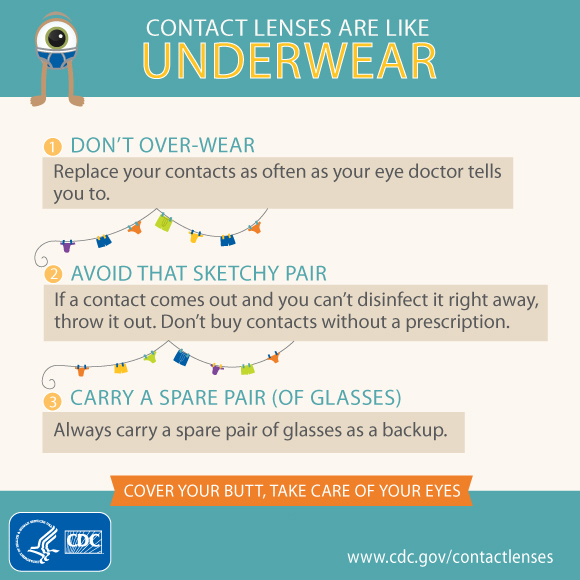Do YOU Practice Proper Hygiene for Your Contact Lenses?
When properly cared for, contact lenses can be an adequate source of vision correction. However, a shocking 98% of contact lens wearers do not practice appropriate hygiene increasing the risk for eye infection1. In fact, some studies show that due to these poor practices, LASIK laser vision correction is safer than contacts!
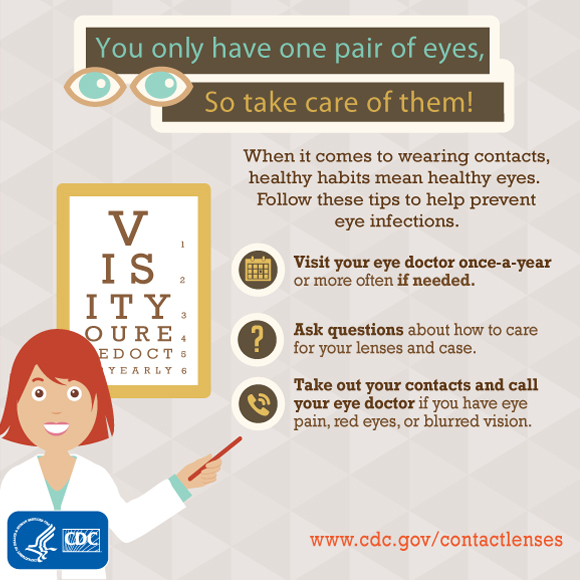
Healthy Habits = Healthy Eyes
To increase awareness for proper care of contact lenses, the CDC (Centers for Disease Control) launched an annual campaign in 2014 specifying a week in August as Contact Lens Health Week. During this week, the CDC encourages good vision and healthy eyes throughout the year. The campaign centers around #OnePairTakeCare highlighting the fact that we only have one pair of eyes so we better take care of them!
How well do you care for your eyes?
Are you guilty of poor contact lens care. Explore the questions below for information on how to have Healthy Habits for Healthy Eyes.
Click on the question to expand the detail.
Do your contacts come into contact with water whether in the shower, swimming pool, hot tub, or even tap or distilled water?
Many lens wearers are unaware that water should not come into contact with your lenses.
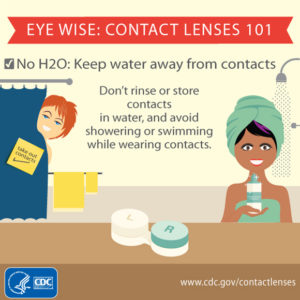 Water can cause soft lenses to change shape, swell, and stick to the eye causing them to be uncomfortable or potentially scratch the cornea (the clear dome-shape on the front of your eye) allowing bacteria to enter the eye.4
Water can cause soft lenses to change shape, swell, and stick to the eye causing them to be uncomfortable or potentially scratch the cornea (the clear dome-shape on the front of your eye) allowing bacteria to enter the eye.4
Most water is not germ-free.4 Bacteria can grow on the lens after just one splash into the pool and since contacts sit on the cornea for an extended period of time, your eyes are continuously exposed to chemicals, bacteria, fungi, or parasites which can lead to a painful corneal infection. The amoeba germ is commonly found in tap water, lake water, and well water. Although rare, this germ can cause a severe type of infection called Acanthamoeba keratitis causing the need for a corneal transplant or in extreme cases, vision loss.11
Prescription goggles are recommended but can be costly and uncomfortable. If you enjoy swimming, boating, and water activities, consider iLASIK as a solution.
Do you wash your hands with soap and water before touching your contact lenses?
You have one of the simplest defenses against germs: washing your hands.
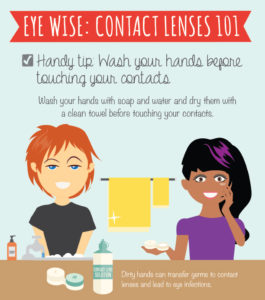 Viruses and other microscopic germs that can cause eye infections get on your hands through everyday activities–door knobs, elevators, hand rails, shopping carts. Washing your hands protects your eyes from the microbes that get on your skin by preventing these germs from transferring to your eyes.12
Viruses and other microscopic germs that can cause eye infections get on your hands through everyday activities–door knobs, elevators, hand rails, shopping carts. Washing your hands protects your eyes from the microbes that get on your skin by preventing these germs from transferring to your eyes.12
Do you sleep in your contacts?
It’s not okay to sleep in your daytime contacts so don’t do it!
 Sleeping in contacts that are meant to be removed at night increases your risk of a corneal infection by 4-5 times!5
Sleeping in contacts that are meant to be removed at night increases your risk of a corneal infection by 4-5 times!5
“It’s like having a plastic bag over your head when you sleep,” says Rebecca Taylor, M.D., spokesperson for the American Academy of Ophthalmology, “It’s not ideal for oxygen exchange.”
Your eyes, corneas to be specific, need oxygen and lubrication. While you’re awake, the cornea receives oxygen. When you are asleep, the cornea gets nourishment and lubrication from tears and the natural fluid of the eye called the aqueous humor. If your contact is covering the cornea while you sleep, it is acting as a barrier between your eyelid and cornea.13
Do you reuse or “top off” your disinfecting solution in your contacts case?
Always use new solution to clean and store your contact lenses.
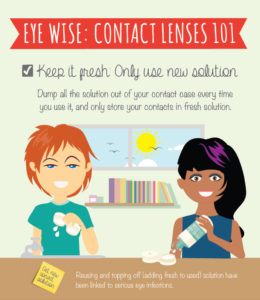 The solution in your case becomes contaminated by any germs that are on your contact lenses or in your case. Adding new solution to used solution lessens the disinfecting power causing an increased risk of infection. Only use fresh solution, never water, to clean your contacts and to store them overnight.5 Use your disinfecting solution the next day to clean your case and let it air dry.
The solution in your case becomes contaminated by any germs that are on your contact lenses or in your case. Adding new solution to used solution lessens the disinfecting power causing an increased risk of infection. Only use fresh solution, never water, to clean your contacts and to store them overnight.5 Use your disinfecting solution the next day to clean your case and let it air dry.
Do you replace your contact lens case regularly?
Change your contact lens case regularly.
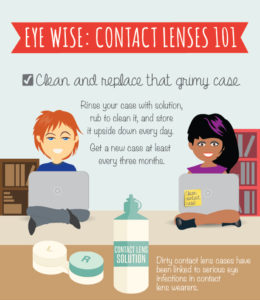 Even when cleaned properly, your contact lens case can still become contaminated by microscopic bacteria causing a risk of an eye infection. Replace your lens case at least every three to four months or, as a rule of thumb, when you open a new bottle of solution.5
Even when cleaned properly, your contact lens case can still become contaminated by microscopic bacteria causing a risk of an eye infection. Replace your lens case at least every three to four months or, as a rule of thumb, when you open a new bottle of solution.5
Do you replace your lenses as scheduled or when they start to bother you?
Contacts are very expensive but don’t be tempted to save money by overwearing them!
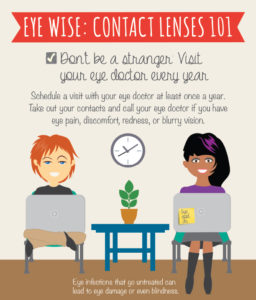 With the price of contacts, it’s tempting to get just a little more use out of a pair. Even with proper cleaning, deposits can build up on the lenses over time affecting the oxygen flow to your eye. Blurred vision, eye pain, and light sensitivity can be signs that a problem has developed involving the cornea.5
With the price of contacts, it’s tempting to get just a little more use out of a pair. Even with proper cleaning, deposits can build up on the lenses over time affecting the oxygen flow to your eye. Blurred vision, eye pain, and light sensitivity can be signs that a problem has developed involving the cornea.5
Visit your eye doctor regularly to check your prescription, the fit of your contacts, and the overall health of your eyes. Adjustments may need to be made and keeping up with your annual visits helps ensure your eyes stay healthy.
Have you ever cleaned your contacts with something other than contact lens disinfecting solution such as water...or even saliva? (Be honest!)
The best way to care for your contacts is to follow The Four Rs:12
- Rub lenses in disinfecting solution when cleaning them. The rubbing action loosens the protein and bacteria build-up. Even if your solution says “no rub”, according to the American Academy of Ophthalmology, rubbing the lens has proven one of the best ways to decrease eye infections.
- Rinse and store your contact lenses in the solution recommended by your eye doctor.
- Rest your eyes by letting them have a break from your contact lenses. Sleeping in your contacts increases the possibility for an eye infection.
- Renew your supply of contacts as directed. Only use the lenses as long as your prescriber recommends. If you use one-month contact lenses, discard them after 30 days and use a new pair. If you wear dailies, don’t attempt to get multiple days out of one pair.
Improper cleaning of your contacts raises the risk of infection. The disinfecting solution recommended by your doctor is the safest and most effective way to clean your contacts and ensure deposits and germs are removed from the lenses.
Have you ever worn lenses not properly fitted by an eye doctor?
Don’t ever purchase contacts online or from a vendor without a prescription. It’s not only dangerous, it is illegal for a vendor to sell them to you.
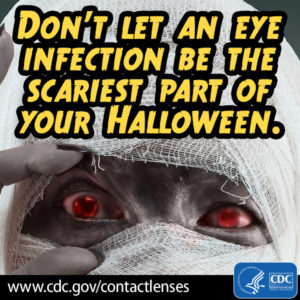 Even if you see clearly without vision correction, contacts are not one-size-fits-all and need to be properly fitted for your eyes. Your eye doctor takes careful measurements determining the diameter, power, and type of lens material that will best suit the unique shape of your eye.
Even if you see clearly without vision correction, contacts are not one-size-fits-all and need to be properly fitted for your eyes. Your eye doctor takes careful measurements determining the diameter, power, and type of lens material that will best suit the unique shape of your eye.
Click here for a “scary” story from a CBS report about the dangers of decorative contacts without a proper fitting.
Contact lenses are “medical devices” regulated by the FDA and it is actually illegal for a vendor to sell contact lenses, whether for vision correction or decorative use, without a prescription. Each year in October, the American Academy of Ophthalmology (AAO) launches a campaign educating consumers about the dangers of wearing contacts that are not properly fitted to your eyes.14 The FDA, American Optometric Association (AOA), and the Entertainment Industries Council (EIC) have now joined the effort and teamed up with American Horror Story for a Decorative Contact Lens Campaign to better educate consumers.
Is LASIK a safer option for your eyes?
LASIK is a SAFER option!
While technology has benefitted both types of vision correction, if you do not practice proper lens care with your contacts, LASIK will be a safer method of helping you see clearly and keeping your eyes healthy.
“Almost everyone who wears contact lenses violates some principle of proper use at some point.” states William Mathers, MD., Oregon Health & Science University Researcher (OHSU). “Either they don’t wash their hands before putting them in or they use tap water to store the lenses. But infections can occur even when this doesn’t happen.”
 In a 2006 study published in the Archives of Ophthalmology, researchers of the OHSU and The Casey Eye Institute determined that contact lens users are actually more likely to develop complications that lead to vision loss over time than patients who have LASIK surgery. Their research concluded that daily contact lens wearers have about a one in 100 chance of developing a serious contact lens-related infection over 30 years of use, and a one in 2,000 chance of suffering significant vision loss as a result of an infection. The risk of significant vision loss due to LASIK surgery is closer to one in 10,000 cases10.
In a 2006 study published in the Archives of Ophthalmology, researchers of the OHSU and The Casey Eye Institute determined that contact lens users are actually more likely to develop complications that lead to vision loss over time than patients who have LASIK surgery. Their research concluded that daily contact lens wearers have about a one in 100 chance of developing a serious contact lens-related infection over 30 years of use, and a one in 2,000 chance of suffering significant vision loss as a result of an infection. The risk of significant vision loss due to LASIK surgery is closer to one in 10,000 cases10.
LASIK has higher SATISFACTION!
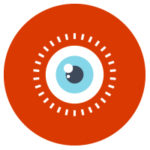 A three-year study comparing visual satisfaction with LASIK and contact lenses was released in May 2016. This study reported 97% of LASIK patients reported higher satisfaction with LASIK than they had previously with contacts (2% of patients were indifferent). Frank Price, MD and his colleagues concluded when compared with contact lens wear, current LASIK technology improved ease of night driving, did not significantly increase dry eye symptoms, and resulted in higher levels of satisfaction at 1, 2, and 3 year follow-up exams.8,9
A three-year study comparing visual satisfaction with LASIK and contact lenses was released in May 2016. This study reported 97% of LASIK patients reported higher satisfaction with LASIK than they had previously with contacts (2% of patients were indifferent). Frank Price, MD and his colleagues concluded when compared with contact lens wear, current LASIK technology improved ease of night driving, did not significantly increase dry eye symptoms, and resulted in higher levels of satisfaction at 1, 2, and 3 year follow-up exams.8,9
LASIK offers more SAVINGS!
 Use the Contact Cost Calculator to determine what you are spending over your lifetime on contacts. Many LASIK patients find their LASIK procedure pays for it’s self over 3-6 years in savings from contact lenses, solutions, and eye exams. Depending on the type of lenses, the average contact lens wearer may invest between $50 and $100 per month on their eyes. With financing options available and payments as low as $112 per month, LASIK may not be much more than you already pay for contacts. Click here to learn more about payment options through CareCredit.
Use the Contact Cost Calculator to determine what you are spending over your lifetime on contacts. Many LASIK patients find their LASIK procedure pays for it’s self over 3-6 years in savings from contact lenses, solutions, and eye exams. Depending on the type of lenses, the average contact lens wearer may invest between $50 and $100 per month on their eyes. With financing options available and payments as low as $112 per month, LASIK may not be much more than you already pay for contacts. Click here to learn more about payment options through CareCredit.
Photo credits: CDC Centers for Disease Control and Prevention; http://www.cdc.gov/contactlenses/materials.html
SOURCES / REFERENCES:
1 “Social Media Library. Contact Lens Facts.” CDC Centers for Disease Control and Prevention, Web. Oct. 21, 2015.
4 “Water and Contact Lenses: Water and contact lenses don’t mix.” CDC Centers for Disease Control and Prevention, Web. June 13, 2014.
5 “Show Me the Science: Data Behind Contact Lens Wear and Care Recommendations.” CDC Centers for Disease Control and Prevention, Web. Jan. 22, 2015.
8 “LASIK: The superior alternative to contacts.” Price Vision Group, Web.
9 “Three-Year Longitudinal Survey Comparing Visual Satisfaction with LASIK and Contact Lenses.” US National Library of Medicine National Institutes of Health (NCBI), Web. May 18, 2016.
11 Boyd, Kierstan. “What You Should Know About Swimming and Your Eyes.” American Academy of Ophthalmology. Aug. 16, 2016.
10 “LASIK vs contact lenses.” OHSU | Casey Eye Institute.
12 Taylor, M.D., Rebecca. “Eye Infections: Be Careful Now or Regret It Later.” American Academy of Ophthalmology. Aug. 18, 2016.
13 “Chan, Amanda L. “This Will Make You Never, Ever Want To Sleep In Your Contact Lenses Again.” The Huffington Post. Aug. 7, 2014.
Cleaning Contacts Video: “Caring For Your Contact Lenses.” YouTube. American Academy of Ophthalmology (AAO) Get EyeSmart. Dec. 22, 2010.
Decorative Contacts Video: “FDA Teams Up for Novel Campaign on Risks of Decorative Contact Lenses.” FDA US Food and Drug Administration. July 24, 2014.

